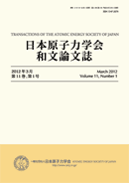
- 1 号 p. 1-
- |<
- <
- 1
- >
- >|
-
小川 良太, 関口 昭司, 礒部 仁博, 服部 功三, 匂坂 充行, 三浦 進2024 年 23 巻 1 号 p. 1-17
発行日: 2024年
公開日: 2024/02/15
[早期公開] 公開日: 2024/02/09ジャーナル フリー HTMLDigital hammering inspection technology using an acoustic emission (AE) sensor has been developed to evaluate the fixed condition of steel plates embedded in concrete. Since supporting structures for such equipment and pipes are welded to the plates, the reliability of the plates should be extremely high especially in nuclear facilities. The development was carried out through mock-up tests and FEM analysis as well as field application tests. It was confirmed that the embedded plates are in the state of being firmly fixed to the concrete when the hammering inspection index of “vibration duration” is below 20 ms. In addition, the stud welded on the back surface of the embedded plates has standard length, when the hammering inspection index of “natural frequency” close to the stud is higher than 1900 Hz.
抄録全体を表示PDF形式でダウンロード (5155K) HTML形式で全画面表示 -
青木 広臣, 山田 憲和, 木嶋 達也, 前田 敏克, 平野 雅司2024 年 23 巻 1 号 p. 18-32
発行日: 2024年
公開日: 2024/02/15
[早期公開] 公開日: 2024/02/09ジャーナル フリー HTMLThe Nuclear Regulation Authority, Japan, established the regulatory requirements for the intermediate-depth disposal of intermediate-level radioactive waste in October 2021. Regarding the inadvertent human intrusion to the intermediate-depth disposal facility, some measures are required in the requirements and will be taken in the design of the facility or in the site selection process. The international standards provided by the IAEA and ICRP have stipulated the needs for measures against human intrusion and the evaluation of human intrusion scenarios as part of safety case. In this paper, we attempt to classify these measures against inadvertent human intrusion and clarify their objectives and functions from the viewpoint of the defence-in-depth approach that has been widely applied in the safety strategy of nuclear installations for preventing accidents and mitigating their consequences. Additionally, effectiveness evaluations of such measures are discussed taking into account some examples of scenarios that have been proposed thus far.
抄録全体を表示PDF形式でダウンロード (1759K) HTML形式で全画面表示 -
北田 淳子2024 年 23 巻 1 号 p. 33-49
発行日: 2024年
公開日: 2024/02/15
[早期公開] 公開日: 2024/02/09ジャーナル フリー HTML
電子付録In this paper, the existing public opinion polls conducted by, for example, news organizations and INSS (Institute of Nuclear Safety System, Inc.) were analyzed and found to indicate that young Japanese were more positive about using nuclear power generation (NPG) than older Japanese after the Fukushima Daiichi accident. This trend was attributed to the change in attitude after the accident, depending on the age group. Two web surveys targeting people in their 20s and 60s revealed the following factors for young people: (1) Young people were less aware of the risks of NPG and knew fewer negative facts about NPG. (2) Young people tended to be indifferent to NPG and viewed it as an acceptable status quo. Factors (1) and (2) were related to young people's low exposure to news and low interest in information on political, economic, and social issues. (3) Young people tended to emphasize the economical and stable supply of electricity rather than risks. (4) The two groups differed in their acceptance of the replacement of old nuclear power plants. Among older people, opinions were strongly related to the direct evaluation of NPG, especially risk awareness, while among young people, opinions about economic emphasis and anxiety about the future, which are not directly related to NPG, were weakly and broadly related.
抄録全体を表示PDF形式でダウンロード (2305K) HTML形式で全画面表示
- |<
- <
- 1
- >
- >|